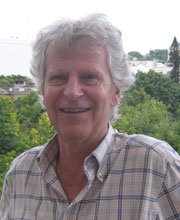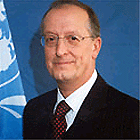Executive Director of the United Nations Office on Drugs and Crime (UNODC)
Vienna
6 December 2008
Dear Mr. Costa,
On 6 December 2007 at the Drug Policy Alliance Conference in New Orleans I asked you the following question:
“Why, after more than 30 years of regulated availability to adults over 18 years, is cannabis use in the Netherlands lower than in most European countries and the USA – and not higher, as would be expected if the prohibition of illicit drugs really was effective?”
I am still waiting for your answer to this question. Although you made some comments about related matters, you did not answer my simple question.
The basic assumption of drug prohibition is that by rigorously enforcing prohibition, drug use will disappear, or at least decrease significantly.
In the Netherlands, the liberal availability of cannabis for more than 30 years has not led to levels of use above the EU average. Although cannabis prohibition is much more rigorously enforced in France than in the Netherlands, the prevalence of cannabis use (last month) in 2003 by 15- and 16-year olds was 22% in France and 13% in Holland, and by 15– to 64-year olds in 2005 5% and 3%. (National Drugsmonitor 2007). This comparison of France and the Netherlands suggests that rigorously enforcing prohibition could even increase drug use.
I use the term “prohibition” because the term “drug control”, that you prefer, is incorrect. One of the many harmful consequences of punitive prohibition is that the lucrative drug market is driven underground where it can not be regulated.
There is no control over the drug market under prohibition.
I asked you the same question for a second time at the UN Commission on
Narcotic Drugs in Vienna on 12 March 2008. You responded (incorrectly) that you had already given me an answer the first time, and that this answer had created problems for you with the Dutch government. You then referred me to the Dutch government and to the mayor of Amsterdam for the answer (apparently unaware of important differences of opinion between them).
This exchange was filmed and can be accessed at: Drogriporter and You Tube
On 15 May 2008, during the International Harm Reduction Conference in Barcelona, having heard that you had visited the coffeeshop ‘De Dampkring’ (‘The Atmosphere’) in Amsterdam on 22 April 2008, I asked you what you had learned from your recent study mission to the Netherlands. You responded that the visit had confirmed your ideas. You announced that a discussion paper (on the relationship between the availability of cannabis and consumption levels, concentrating on the situation in the Netherlands) would appear on the UNODC website ”very soon”.
You also claimed to have found that addiction rates to cannabis in Amsterdam are three times higher than in any other large European cities. (Your response was filmed and can be accessed at: You Tube )
It is no exaggeration to say that your response was greeted in Barcelona with widespread disbelief, and eager anticipation of the discussion paper that you announced. Among experts it is common knowledge that cosmopolitan cities like Amsterdam have more of every kind of drug consumption, legal and illegal, than smaller cities. This is also true of such cities in punitive prohibition states.
More than six months later, the paper that you promised appears not to have been published on the UNODC website.
However, on 23 June 2008 you published in your blog, ‘Costa’s Corner’, an informal report that you had written shortly after your visit to Amsterdam. This entry on your blog contains no sources or references. It does not accurately reflect scientifically rigorous epidemiological data published by reputable sources. In addition, you ignored the well-known comparison of cannabis use in San Francisco and Amsterdam by Reinarman and Cohen, the only study that actually compares similar cities with the same robust methodology (The Limited Relevance of Drug Policy: Cannabis in Amsterdam and in San Francisco, Am J Public Health. 2004;94:836-842).
This study shows that levels of cannabis use (‘ever’ and ‘> 25 times lifetime’) in liberal Amsterdam are much lower than in the more restrictive environment of San Francisco. The study also showed that the use of other illicit drugs (heroin, cocaine, amphetamine etc) was much higher in the more restrictive environment of San Francisco. A forthcoming paper also shows that in San Francisco a three times higher proportion of cannabis users were offered other illicit drugs on the last occasion that they obtained cannabis.
See also: TNI UNGASS 10-year review, the Cannabis Debate: Polak vs Costa, 27 May 2008.
Instead of reacting to your blog immediately, I decided to wait for the publication of your discussion paper. On 9 September 2008, I submitted a ”Contact Form” on the website www.unodc.org to ”General Information”, asking for the discussion paper. I have not received a reply.
How should this be interpreted? It is now one year since I asked you to explain why cannabis use in the more liberal environment of the Netherlands is lower than most other European countries and six months since you publicly announced a discussion paper on the subject. In the meantime you continue to assert claims about cannabis use in the Netherlands that you are unable to substantiate.
I am reluctant to conclude that you are unable to admit that cannabis use in the Netherlands is lower than in most European countries and the USA, because after more than 30 years of de facto regulated availability (to adults over 18 years), these data are further proof that the prohibition of illicit drugs has failed and can not be justified.
I now pose the following questions to you:
1. Is a discussion paper (on the relationship between availability of cannabis and levels of use and problematic use) being prepared?
2. If so, when can we expect to see it?
3. On which data did you base your claim in your blog of 23 June 2008 that Amsterdam has 3x higher levels of cannabis use compared with other major European cities?
4. Do you acknowledge the data published by EMCDDA (European Monitoring Centre for Drugs and Drug Addiction) which place the Netherlands in the mid-range of prevalence figures in Europe and well below US figures?
5. Do you acknowledge that the coffeeshop system has not led to higher levels of cannabis use in the NL than in neighboring countries?
6. How do you reconcile the expectations of prohibition with the empirical evidence drawn from 30 years experience in the Netherlands?
In the absence of a response, I will be forced to draw the conclusions that you, as Director General of the UNODC have no adequate answer to my question about the relatively low levels of cannabis use in the Netherlands, and that you cannot substantiate your claim that cannabis consumption in Amsterdam is three times higher than in other comparable cities.
If, as I suspect, you have some doubts about drug prohibition, I would suggest a better course to you, a more honourable one.
Fear of retaliation is one of the reasons why some people won’t admit they were mistaken in their support for prohibition, not even when confronted with convincing and conclusive evidence.
Fear of loss of face is another reason. Some judges, police chiefs, and other high functionaries only come out of the closet as “legalizers” after their retirement.
In your report to the Commission on Narcotic Drugs in March 2008 (entitled “Making Drug Control Fit for Purpose”) you acknowledged the harmful negative consequences of drug prohibition and you came remarkably close to conceding that this policy is ‘an emperor without clothes’.
It would be to your eternal credit to acknowledge the fundamentally flawed nature of prohibition, and its apparent ineffectiveness, high costs and severe counter productive effects, while still in office and not only after your retirement.
Yours sincerely,
Fredrick Polak, M.D., psychiatrist, Amsterdam, the Netherlands
member of the Steering Committee of ENCOD (European Coalition for Just and Effective Drug Policies)
Email: fpolak@planet.nl




 Creative Commons Attribution
Creative Commons Attribution